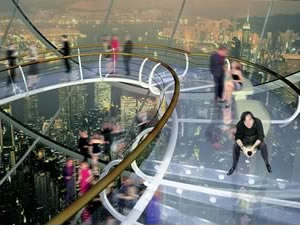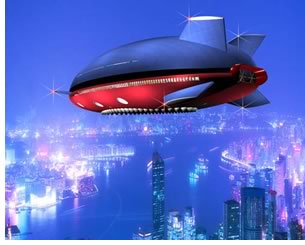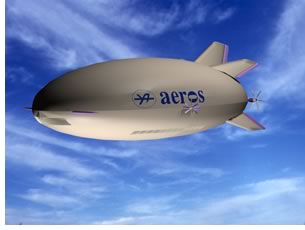

6/2006

by Russell Boniface
Look, up in the sky! It’s a bird! It’s a plane! It’s a . . . flying cruise ship?
Not exactly. Imagine a first-class ocean liner—without the ocean. Instead, substitute blue waves with blue skies. It’s still not a bird, and it’s still not a plane. It’s the Aeroscraft, a luxury ship that floats on air, not water.
 Aeroscraft
is a new type of air vehicle that will allow luxury travelers to boldly
fly where no luxury travelers have flown before. California-based Worldwide
Aeros Corp, a manufacturer of FAA-certified lighter-than-air ships, has
paired with Hawaii-based architects Wimberly Allison Tong & Goo
(WATG), who specialize in interior hospitality design for luxury destinations,
to design the sky-high, luxury aircraft. Although it may look like a
blimp, looks are deceiving; rather, it is a specially designed craft
that operated more akin to a low-flying, slow-moving jet. Both firms
hope to have a prototype floating in the skies by 2010.
Aeroscraft
is a new type of air vehicle that will allow luxury travelers to boldly
fly where no luxury travelers have flown before. California-based Worldwide
Aeros Corp, a manufacturer of FAA-certified lighter-than-air ships, has
paired with Hawaii-based architects Wimberly Allison Tong & Goo
(WATG), who specialize in interior hospitality design for luxury destinations,
to design the sky-high, luxury aircraft. Although it may look like a
blimp, looks are deceiving; rather, it is a specially designed craft
that operated more akin to a low-flying, slow-moving jet. Both firms
hope to have a prototype floating in the skies by 2010.
Up, up, and away
The elongated, oval-shaped Aeroscraft cruise ship, also referred to as
an air yacht or airborne hotel, is expected to fly passengers to attractive
destinations in style and afford them scenic vistas in the tradition
of the dirigibles of yesteryear. Aeros Corp. believes that with the
capability of very slow, low, and quiet flight speed, Aeroscraft can
become a perfect luxury-viewing platform.
Nearly two football fields long, with dimensions of 165 feet high, 244 feet wide, and 850 feet long, Aeroscraft is a hybrid of blimp and traditional airplane technology. Aeroscraft is like a blimp in that helium will provide a portion of lift. But, unlike a blimp, additional lift will come from the deflection of air by the craft’s shape, the same way a plane gets lift. The final piece of lift will come from six electric, hydrogen-fuel-cell aft jet engine propellers. Once the craft reaches cruising altitude—around 8,000 feet—Aeroscraft’s helium, shape, and fins will keep it afloat, while the giant rear propellers will move it leisurely forward through the troposphere.
 Aeroscraft
will be made of a light but rigid aluminum honeycomb truss shell, making
it a rigid craft, as opposed to a blimp, which is more like a balloon.
Aeroscraft will be considered a heavier-than-air ship because it is part
traditional aerodynamics, whereas a blimp is considered a lighter-than-air
ship because it relies solely on helium buoyancy. Aeroscraft’s
hull will be made from a carbon composite, not a rubber-coated fabric,
which also differentiates it from blimps and makes it more like a jet.
One thousand composite carbon plastic tiles will compose the hull. Twelve
small airbags, called ballonets, will hold helium and air in the lower
hull interior; most blimps have one central helium gasbag and one central
air ballonet.
Aeroscraft
will be made of a light but rigid aluminum honeycomb truss shell, making
it a rigid craft, as opposed to a blimp, which is more like a balloon.
Aeroscraft will be considered a heavier-than-air ship because it is part
traditional aerodynamics, whereas a blimp is considered a lighter-than-air
ship because it relies solely on helium buoyancy. Aeroscraft’s
hull will be made from a carbon composite, not a rubber-coated fabric,
which also differentiates it from blimps and makes it more like a jet.
One thousand composite carbon plastic tiles will compose the hull. Twelve
small airbags, called ballonets, will hold helium and air in the lower
hull interior; most blimps have one central helium gasbag and one central
air ballonet.
Aeroscraft will have a capacity for 250 passengers and a 500-ton payload. The airship will take off and land vertically like a helicopter, so it will not need a runway. Takeoff and landing with not need a ground crew because the Aeroscraft's belly will create a vacuum for anchorage upon landing, which reverses to launch the aircraft into the sky. The crew will navigate the craft in an aluminum alloy gondola, integrated into the hull. The ship will have an estimated top speed of 174 mph and a range limit of about 6,000 miles. A coast-to-coast trip would take about 18 hours.
The cavernous interior cabin will be approximately 125 feet by 82 feet, and, if all goes as planned, will accommodate luxury staterooms, restaurants, nightclubs, lounges, spas, observation areas, and even casinos—just like a luxury ocean liner or luxury hotel. An innovative engineering feature is an automated buoyancy-management system that will compensate onboard weight. For example, if all the passengers suddenly run to the one side of the craft to see the Washington Monument, the blimp will remain balanced by sucking in outside air.
 And, as with balloons, it will come in different colors!
And, as with balloons, it will come in different colors!
Fly for fun
WATG has designed several luxury destination projects around the world,
like Atlantis Paradise Island in the Bahamas and The Venetian Resort-Hotel-Casino
in Las Vegas. Howard J. Wolff, senior vice president of WATG, explains
enthusiastically that the idea of the ship has a great deal of credibility. “When
speaking about leisure travel, you could describe it as an airship
hotel, or a cruise ship in the sky. An early, smaller version might
be more like an air-yacht, but there is great potential down the line
for more.” Wolff is a firm believer that the traveler will be
able to enjoy luxury that is unequivocal to the routine—and perhaps
mundane—getaway experiences. “Windows will be extremely
large, affording incredible views. It will be unprecedented for sightseeing
and day-trip landings. It will have the ability to take off and land
anywhere—in a meadow, on snow, or on water—so day-trip
excursions will be an exciting possibility. And it will eliminate the
hassles associated with airports.”
Wolff describes what he sees as the two primary markets for the Aeroscraft. “Free-wheeling singles; dual-income, no-child couples; and alternative lifestylers—people who love to travel and want to experience all life has to offer without limits or boundaries,” he points out. “And folks who’ve cashed in their 401(k)s and have both the time and money to see the world. It will be a great way for them to see the world from a unique vantage point at a leisurely pace and in an environmentally friendly way.”
 A smaller, 200-foot-long Aeroscraft prototype, referred to as an air
yacht, is being geared for day-cruise scenarios and, ideally, will hold
up to 30 passengers. It is expected to be completed in three years. Once
FAA-certified, Aeros will start building the first full-scale version.
A smaller, 200-foot-long Aeroscraft prototype, referred to as an air
yacht, is being geared for day-cruise scenarios and, ideally, will hold
up to 30 passengers. It is expected to be completed in three years. Once
FAA-certified, Aeros will start building the first full-scale version.
WATG designer and senior associate Brian Husting, AIA, is excited about the possibilities a hospitality craft poses for interior concepts. “Worldwide Aeros came to us because they thought people may want this for other reasons than just moving cargo,” Husting explains. “They saw an opportunity for a hospitality twist, perhaps someone’s personal yacht, a hospitality vehicle with parties in the air, or a day-trip cruise with land excursions. We theorized what kind of experience the air yacht would be if an individual, a group of four, or a group of 20 take it for a day cruise. Eventually it is not inconceivable that the craft can turn into a hotel where people would stay for longer periods, but, for now, we are suggesting day-cruise possibilities, factoring in the many commercial possibilities.”
Husting calls it a chicken and egg situation. “This craft can be many things, so let’s see who it might appeal to, and then work on a prototype. For example, high rollers at MGM in Las Vegas could take a cruise over the Grand Canyon. Or maybe there is an exclusive opportunity for people to hover over the Super Bowl. Maybe it can hold an after-concert party for the Rolling Stones. You can imagine a reality show being filmed on it or a concert being performed up there. There’s also the idea of the craft taking excursions where it carries vehicles and lands to allow passengers to go drive, snowmobile, or jet ski. The ship can become a platform to do some wild things.”
 When Husting looked at interior design materials, he says he wanted
to give it a futuristic edge. “Perhaps use forms that are not easily
recognizable that create space without weight. For example, futuristic
plastics, bubbles, and elements that might be more translucent. What
we want to do is to expose them to the unexpected and wilder elements
of interior design with that hospitality twist. We will definitely open
up the space for viewing, and have glass floors to give people the experience
of floating over incredible landscapes. We are also proposing dinning
areas, a nightclub experience, an area of gaming, observations areas,
a lounge, and spas. But the more you think about what the ship can be,
the more your mind takes you to a lot of design places.”
When Husting looked at interior design materials, he says he wanted
to give it a futuristic edge. “Perhaps use forms that are not easily
recognizable that create space without weight. For example, futuristic
plastics, bubbles, and elements that might be more translucent. What
we want to do is to expose them to the unexpected and wilder elements
of interior design with that hospitality twist. We will definitely open
up the space for viewing, and have glass floors to give people the experience
of floating over incredible landscapes. We are also proposing dinning
areas, a nightclub experience, an area of gaming, observations areas,
a lounge, and spas. But the more you think about what the ship can be,
the more your mind takes you to a lot of design places.”
But filling up the volume of the behemoth craft and meeting the demands of air travel are challenges, explains Husting. “The craft is fairly wide—maybe 60-80 feet for a day cruiser. It’s not like an airplane. For 20–30 people on a day cruise, we are stretched left to right to generate a dynamic space with all the volume in between the windows. We want to get great activities against the edges where the windows are, but we are challenged with the inside portion, which is so far removed from windows. The ship will be so bulbous that energizing that space is the tough part. We proposed big party spaces and smaller intimate spaces that might be on an upper level. Fortunately, a hotel version will be less of a problem because we would need to use the full volume for overnight accommodations. Then there are issues such as turbulence and storms. In that sense, it’s definitely more like a plane than a cruise ship. The challenge is to make the ship futuristic but safe.”
It’s not a blimp
Edward Pevzner, business development manager for Worldwide Aeros Corp.,
is quick to point out that Aeroscraft is not a blimp. “It’s
not a blimp, it’s not an airship—it is a totally new vehicle,” he
stresses. “Today we have three types of vehicles: air vehicles—which
are airplanes—helicopters, and airships—which means blimps.
So Aeroscraft is going to be the fourth type. And it is going to incorporate
the technologies of all the three other vehicles."
 The technology for the flying yacht, cruise ship, or hotel will be derived
from what Aeros currently uses in its fleet of lighter-than-air cargo
aircraft. Pevzner hopes its cargo-carrying Aereoscraft will be able to
deliver store merchandise from a factory straight to a store. It also
foresees delivering supplies to hard to reach locations, such as an offshore
oil rig, or places where a transportation infrastructure is limited or
does not exist.
The technology for the flying yacht, cruise ship, or hotel will be derived
from what Aeros currently uses in its fleet of lighter-than-air cargo
aircraft. Pevzner hopes its cargo-carrying Aereoscraft will be able to
deliver store merchandise from a factory straight to a store. It also
foresees delivering supplies to hard to reach locations, such as an offshore
oil rig, or places where a transportation infrastructure is limited or
does not exist.
“The initial idea for Aeroscraft was to create a more effective cargo transportation system,” Pevzner explains. “There are so many places in the world with no infrastructure and there is no way to bring cargo to those areas, such as north of Canada, the Amazons in Brazil, or underdeveloped areas in Africa and Australia. With Aeroscraft, there will be no need for intermodal transportation. Even urban areas like the Port of Los Angeles, where the freeways are clogged, cargo Aeroscraft will be able to drop in and out like a helicopter, he says. “Aeroscraft will provide the movement of cargo from Point A to Point B. And Aeroscraft will be able to land anywhere … even in a strawberry field.”
 Pevzner believes Aeroscraft has the potential to be a “modern
marvel” in terms of cargo transport. “The moving industry
started with the pharaohs, but the future will be the Aeroscraft.”
Pevzner believes Aeroscraft has the potential to be a “modern
marvel” in terms of cargo transport. “The moving industry
started with the pharaohs, but the future will be the Aeroscraft.”
Lifting luxury to new heights
Meanwhile, Worldwide Aeros is aiming to get the luxury aircraft sky-trekking
by 2010. For WATG, Wolff sounds anxious for the design challenge. “We
involve ourselves in the design of worldwide projects that combine
luxury with wellness, luxury with sustainability, and luxury with local
culture. The Aeroscraft will be a pleasure craft for people to wine,
dine, and enjoy themselves and the view.”
Husting agrees. “Once someone writes the check for the first one, I think you will see the idea take off. It’s not that far out. It is something that the world might have seen in the past, with dirigibles, but it’s a re-emergence of that, with newer, safer technology.”
Copyright 2006 The American Institute of Architects.
All rights reserved. Home Page ![]()
![]()
Did you know . . .
The Aeroscraft has something in common with the original French-designed dirigible because of the use of a rigid, trussed framework, and, as with dirigibles, for being a passenger transport. Dirigibles became known as zeppelins in the early 20th century when the Germany-based Zeppelin Company bought the rights to the original 19th century dirigible design. (Dirigible is French for “steering.”)
In the 1920s and 1930s, airships using the Zeppelin Company’s construction method were sometimes referred to as zeppelins even if they had no connection to the Zeppelin business. Several airships of this kind were built in the USA and Britain.
Passenger zeppelins reached their height of popularity in the 1930s when the airships Graf Zeppelin and Hindenburg operated regular transatlantic passenger flights between Germany and both North and South America.
Popular myth! In the early 20th century, the United States military had two classes for airships: Type A-rigid and Type B-limp, hence "blimp."
Strange but true! The term "blimp" is onomatopoeic. “Blimp” is the sound the airship makes when one taps its airbag envelope.
One Zeppelin idea back in the ’30s that never made it into construction was to provide the ability to connect several zeppelins to form a flying wagon train! It was dubbed the “steerable air-cruising train!” (hmm . . . any ideas out there?)
![]()